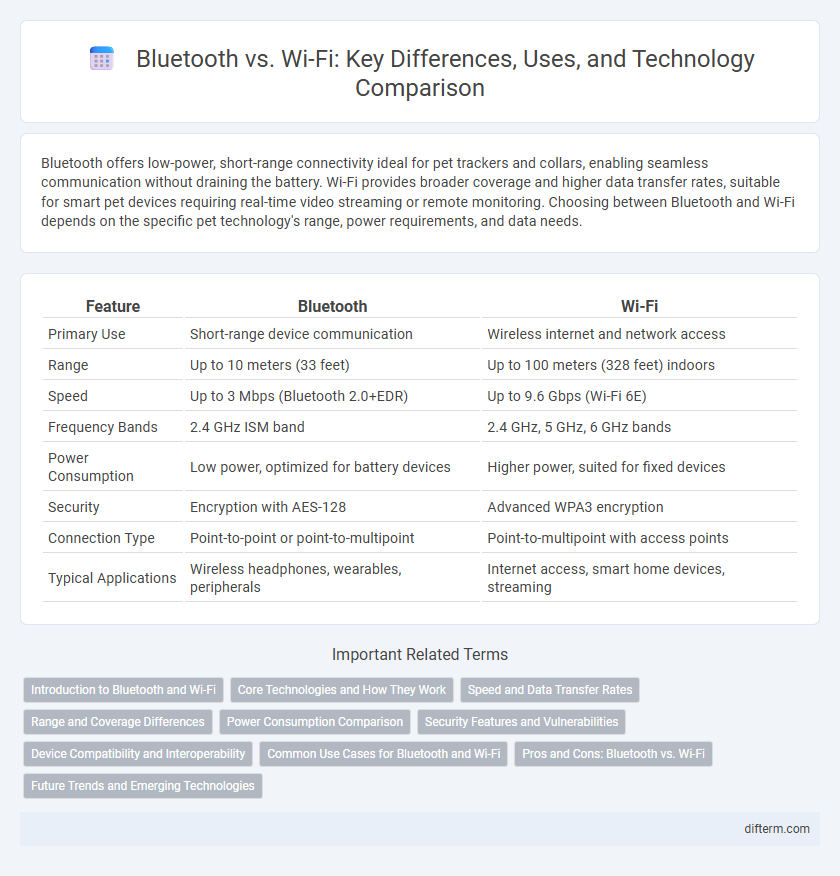Bluetooth offers low-power, short-range connectivity ideal for pet trackers and collars, enabling seamless communication without draining the battery. Wi-Fi provides broader coverage and higher data transfer rates, suitable for smart pet devices requiring real-time video streaming or remote monitoring. Choosing between Bluetooth and Wi-Fi depends on the specific pet technology's range, power requirements, and data needs.
Table of Comparison
| Feature | Bluetooth | Wi-Fi |
|---|---|---|
| Primary Use | Short-range device communication | Wireless internet and network access |
| Range | Up to 10 meters (33 feet) | Up to 100 meters (328 feet) indoors |
| Speed | Up to 3 Mbps (Bluetooth 2.0+EDR) | Up to 9.6 Gbps (Wi-Fi 6E) |
| Frequency Bands | 2.4 GHz ISM band | 2.4 GHz, 5 GHz, 6 GHz bands |
| Power Consumption | Low power, optimized for battery devices | Higher power, suited for fixed devices |
| Security | Encryption with AES-128 | Advanced WPA3 encryption |
| Connection Type | Point-to-point or point-to-multipoint | Point-to-multipoint with access points |
| Typical Applications | Wireless headphones, wearables, peripherals | Internet access, smart home devices, streaming |
Introduction to Bluetooth and Wi-Fi
Bluetooth is a short-range wireless technology designed for exchanging data between devices over distances typically up to 10 meters, using low energy and frequency hopping to minimize interference. Wi-Fi provides high-speed internet access and network connectivity over longer ranges, generally within 30 to 100 meters, relying on radio waves in the 2.4 GHz and 5 GHz frequency bands. Both technologies support wireless communication but serve distinct purposes, with Bluetooth optimized for device-to-device connections and Wi-Fi focused on broader network access.
Core Technologies and How They Work
Bluetooth uses short-range radio frequency in the 2.4 GHz ISM band to establish ad-hoc, point-to-point, or point-to-multipoint connections optimized for low power consumption and device interoperability. Wi-Fi operates on 2.4 GHz and 5 GHz bands utilizing IEEE 802.11 standards to create high-speed wireless local area networks (WLANs) with broader coverage and greater data throughput. Bluetooth relies on frequency hopping spread spectrum (FHSS) to minimize interference, whereas Wi-Fi employs orthogonal frequency-division multiplexing (OFDM) for efficient data transmission and network scalability.
Speed and Data Transfer Rates
Wi-Fi generally offers higher speed and data transfer rates compared to Bluetooth, with modern Wi-Fi standards such as Wi-Fi 6 delivering speeds up to 9.6 Gbps, while Bluetooth 5.2 maxes out at around 2 Mbps for classic Bluetooth and 3 Mbps for Bluetooth Low Energy. Wi-Fi is ideal for bandwidth-intensive tasks like streaming or large file transfers due to its broad frequency bands and stronger signal range. Bluetooth is optimized for low-power, short-range communication, excelling in connecting peripheral devices but limited in throughput compared to Wi-Fi technology.
Range and Coverage Differences
Bluetooth typically operates within a short range of up to 100 meters, making it ideal for personal area networks and device-to-device communication in close proximity. Wi-Fi offers significantly greater coverage, often extending up to 250 meters indoors and even further outdoors, supporting broader local area networks and internet access. The difference in range and coverage between Bluetooth and Wi-Fi impacts their respective use cases, with Bluetooth suited for low-power, short-distance connectivity and Wi-Fi designed for high-speed, long-range networking.
Power Consumption Comparison
Bluetooth technology typically consumes significantly less power than Wi-Fi, making it ideal for battery-sensitive devices like wearables and IoT sensors. Bluetooth Low Energy (BLE) protocols optimize power usage by maintaining short connection intervals and low duty cycles. Wi-Fi generally requires higher power due to continuous data transmission and longer range, suitable for bandwidth-intensive applications but less efficient for energy conservation.
Security Features and Vulnerabilities
Bluetooth security features include encryption and authentication protocols such as Secure Simple Pairing (SSP) and AES-128 encryption, reducing risks of eavesdropping and man-in-the-middle attacks. Wi-Fi employs stronger security standards like WPA3, which offers enhanced encryption and protection against brute-force attacks, but remains susceptible to vulnerabilities in outdated protocols such as WEP and WPA2. Both technologies require regular firmware updates and secure configuration to mitigate risks from exploits like BlueBorne for Bluetooth and KRACK for Wi-Fi.
Device Compatibility and Interoperability
Bluetooth offers seamless device compatibility across a wide range of consumer electronics, including smartphones, headphones, and wearables, thanks to its standardized protocols and widespread adoption. Wi-Fi supports higher data transfer speeds and broader network connectivity, enabling interoperability among laptops, smart home devices, and IoT ecosystems with varying operating systems. Both technologies prioritize cross-platform integration, but Bluetooth excels in short-range personal device connections while Wi-Fi dominates extensive network environments.
Common Use Cases for Bluetooth and Wi-Fi
Bluetooth is widely used for short-range wireless communication in devices like wireless headphones, fitness trackers, and smart home gadgets, facilitating seamless device-to-device connections with low power consumption. Wi-Fi provides high-speed internet access and network connectivity for computers, smartphones, and smart TVs within homes and offices, supporting bandwidth-intensive applications like video streaming and online gaming. Bluetooth excels in personal area networks with limited data transfer, while Wi-Fi dominates larger local area networks requiring robust data throughput and coverage.
Pros and Cons: Bluetooth vs. Wi-Fi
Bluetooth offers low power consumption and seamless device pairing, ideal for short-range connections like headphones or wearables, but it suffers from limited bandwidth and slower data transfer compared to Wi-Fi. Wi-Fi provides higher speeds and broader coverage, supporting complex data exchanges and multiple devices simultaneously, though it consumes more power and requires stronger security measures. Choosing between Bluetooth and Wi-Fi depends on factors such as range, data rate needs, power efficiency, and overall connectivity environment.
Future Trends and Emerging Technologies
Bluetooth is evolving with Bluetooth 5.4, emphasizing enhanced range and energy efficiency, while Wi-Fi 7 aims to deliver multi-gigabit speeds and ultra-low latency for demanding applications. Emerging technologies like Bluetooth mesh networking support scalable IoT deployments, whereas Wi-Fi integrates AI-driven spectrum management to optimize connectivity in dense environments. Future trends indicate convergence of Bluetooth and Wi-Fi protocols to enable seamless, high-performance wireless ecosystems powering augmented reality, smart cities, and Industry 4.0 innovations.
Bluetooth vs Wi-Fi Infographic

 difterm.com
difterm.com